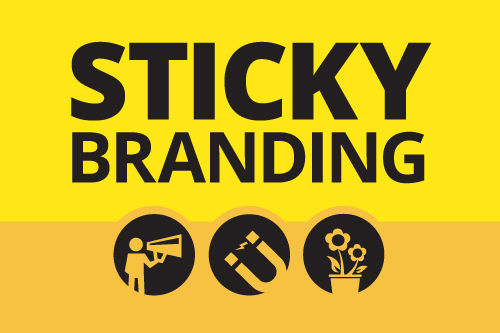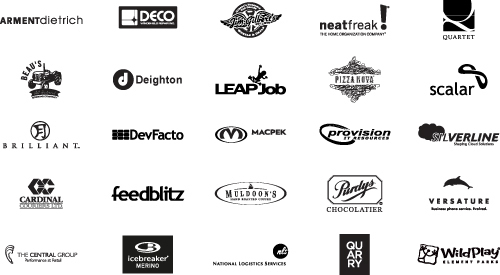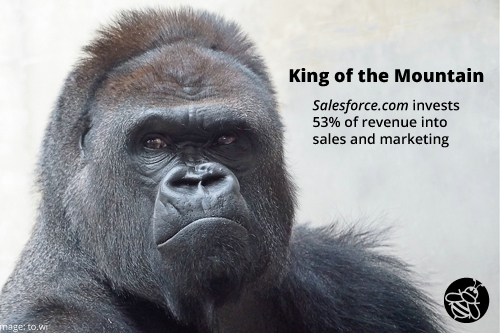Jeremy Miller's Blog, page 41
December 4, 2014
Selling Innovation in a Commoditized Market
Selling a new innovation or a new concept is hard. You can see what your clients need. Your company has developed products and services to address that need. You have the ability to deliver amazing results.
But your clients are resistant. They don’t get it, or they’re not prepared to change.
So they ply you with platitudes, “This looks amazing, but it’s two years ahead of what we need.” Or some other compliment veiled as a brush off.
The issue is not one of innovation or customer understanding. The issue is branding����� positioning an innovation requires a different approach.
Three modes of selling
There isn’t a one size fits all approach to branding and business development, because there are three distinct sales models:
Aggregate Market: Selling to existing customers. They know you, like you, and they know how to buy from you. This market can also be more receptive to new ideas, because there is already the seeds of trust.
Established Market: The second mode of selling is to an Established Market. These are traditional products and services that companies are already using: office supplies, computers, accounting services, and so forth. These are known quantities, and do not require CEO approval to make a purchase.
New Paradigm or New Concept: The third mode of selling is for a New Paradigm or a New Concept. These are products and services a company has not purchased before. These purchases require executive decision, and are often transformative for the business.
Selling an innovation falls under a New Paradigm or Concept model.
An example of buying modes
For the purposes of new business development, let’s focus on the second two modes: Established Market and New Paradigm/Concept.
Social media is a good example. From 2004 to 2010, social media was a New Concept. Companies didn’t understand how to use Facebook, Twitter, and other platforms to market their services.
CEOs and business owners were going to conferences to learn about social media. They were hiring social media experts, and investing in social media strategies and concepts. They were buying a New Concept. The consultants sold to the top of the organization, and they sold strategically.
Now, companies get social media. It has transitioned from a New Concept to an Established Market (a commodity). The CEO doesn’t need to be involved in hiring social media experts. He can delegate the decision to a marketing manager or another operations staff.
Once a company understands a product or service and has purchased it, they become educated buyers. The purchase is no longer a New Concept or a New Paradigm.
Comparing Apples to Oranges
Branding in an Established Market is about differentiation: how are your products or services unique to alternatives in the category. It’s a question of differentiating apples from apples.
A New Paradigm or Concept has a different branding challenging ��� it’s apples to oranges.
When Salesforce.com launched in 2000 it was a New Paradigm in the CRM industry. It was the first cloud-based or software-as-a-service customer management application for businesses. Salesforce led with a bold positioning statement, “End of Software.”
Salesforce.com embraced the paradigm shift in its industry, and made it the defining factor of its brand. Salesforce.com��wasn’t focused on comparing its features to traditional CRM systems. It was about how the product was categorically different.
Lead with purpose
Peter Drucker wrote, “Business has only two functions ��� marketing and innovation.”
Embrace innovation, and sell it with purpose.
Why is your company’s innovations important? How are your products and services different from traditional options? Why is it a New Concept or New Paradigm?
Traditional approaches to sales and marketing are not effective for selling a new innovation. Instead, focus on the brand ��� brand the innovation to sell.
December 2, 2014
Do You Believe In Your Brand?
This may sound like a trite question, but do you? Do you really believe in your brand?
Behind every Sticky Brand are people ��� smart, ambitious, impatient people. People who believe in their brand so deeply that they will do anything in their power to make it a success.
This belief. No, let’s rephrase that. This passion creates an energy and a momentum that makes a brand infectious.
Customers are drawn to companies that have passionately, engaged employees. They see the enthusiasm of the people behind the brand, and are drawn to that energy too.
What do you believe?
How committed are you to your brand?
Do you believe your brand is better than the competition? Do you believe your brand should be your customers’ first choice? Do you believe in your brand’s innate value?
These aren’t intellectual questions. Don’t answer them from the head; answer from the heart. Can you respond to each question with a resounding ���yes,��� or do you waver?
Is there something holding you back?
It’s ok to waver and not give a secure statement. We all face an uphill battle to grow remarkable brands.
The competition is steep. Customer loyalty is sparse. Employee engagement is hard to sustain. And there’s never enough cash to invest in your business and brand.
It’s only human to have a few doubts about the potential of your brand. But don’t let those doubts derail you or slow you down. Let them fuel you.
Identify your doubts, and identify how you can overcome them. And if you can’t overcome them, focus on what your company can do better than anyone else.
Purpose fuels belief
Tim Sanders, author of Love Is The Killer App, says, ���Purpose is a mission that is driven towards something greater than yourself.���
What’s your purpose? What are you striving for in your company?
Clearly understanding your purpose is a source of energy. And it is the source of your belief in your brand. Your purpose is what separates your business from everyone else.
If you’re committed to your company’s purpose, you believe in your brand.
November 27, 2014
Giving Thanks: Take the Thank You Challenge
One of the big perks of being a Canadian married to an American is two Thanksgivings. Double the family, double the turkey hangovers, double the football. It’s a pretty sweet deal.
As I pack up my things for the Thanksgiving weekend, I am pausing to consider how cool it is to be in business today.
You have an opportunity to work with and serve people every day. You have an opportunity to bring value to them, and you have an opportunity to receive value. It’s pretty amazing.
But in the hustle and bustle of the holidays, it’s easy to lose sight of how good we’ve got it. Over the next week try a little exercise. See how many times you can say “thank you.”
Send a Thank You note
The art of the “Thank You” note is not lost. Pick up some note cards, find yourself a writing instrument, and write a few handwritten notes.
Send them to your clients. You wouldn’t be in business without them.
Send them to your vendors and partners. They help you do the work you do.
Send them to your friends and family. It’s Thanksgiving. Keep the cheer going beyond the weekend.
Try to send at least a card a day. And if you can do more, by all means send more. You don’t have to wait for Christmas to acknowledge the important people in your business and your life.
Acknowledge your team
You wouldn’t be where you are without your team.
It’s easy to take your team for granted. You work with them every day. They’re a constant. But their work and their participation is essential for your company.
Acknowledge them by doing something unexpected. Order a few pizzas for your team, and have an impromptu wine and pizza lunch. It’s fun. It’s not too expensive. And you can demonstrate how much your team means to you.
Appreciate the little things
Stop and smell the roses.
The next 30 days are busy ��� they’re busy for everyone. Black Friday is the start of the holiday season. There will be tons of seasonal activities on top of wrapping up your work priorities for year end.
Don’t let the season overwhelm you. Take stock of all the good things going on in your life, your career, and your business.
Set a goal and measure your progress
The purpose of the Thank You exercise is to be purposeful. Set a goal. How many Thank Yous will you send over the next seven days? One a day, five a day, ten a day? Set your goal, and track your progress.
Take the week and give thanks. It’s a great exercise to take on, and it helps put life into perspective.
November 25, 2014
Sticky Branding (the book): What it’s all about
Over the past few weeks I’ve been beating the drum about my upcoming book, Sticky Branding: 12.5 Principles to Stand Out, Attract Customers & Grow an Incredible Brand.
The book launch event is on January 14th at 5pm in Toronto. I hope you can make it. It’s going to be an awesome event. And the Launch Team is coming together to review the book and start the promotion engine.
But I realized, I haven’t told you about the book: what is it, who it’s for, why you want a Sticky Brand, and other key details. I’ve been receiving lots of questions, and I thought it would be fun to share answers to 8 questions I receive all the time.
“Tell us about the book”
Sticky Branding is your branding playbook. It provides ideas, stories, and exercises to make your company stand out, attract customers, and grow an incredible brand.
It’s written for companies that don’t have endless resources and budgets, but have the drive and desire to innovate and grow a Sticky Brand.
The book is easy to read, reference, and apply the ideas to��your business. It has a modular design providing 12.5 Principles to grow a Sticky Brand, organized into four sections:
Position to Win: Sticky Brands play to win. They focus all their expertise and resources on where they play, who they serve, and how they deliver value to their customers.
Authentic Differentiation: Make your brand Visibly Different. Sticky Brands don’t behave like faceless companies. They stand out because they reveal their personality, share their opinions, and build real customer relationships.
Punch Outside Your Weight Class: Make your brand so visible and engaging that it’s hard to ignore. Sticky Brands stand out in their industry. They can compete and win against the big guys, because they’re not afraid to blow their own horns.
Over Commit, Over Deliver: Sticky Brands are deeply committed to the performance of their products and services and the results they deliver. That focus on client results empowers their teams to go above and beyond the call of duty.
“Why do I want a Sticky Brand?”
Simple: sales. A strong brand makes your business more findable, referable, memorable, and desirable. It makes it more appealing, and draws customers to you. It gives your business a clear competitive advantage.
You will achieve five distinct benefits by growing your company into a Sticky Brand:
Attract more customers
Sell more faster
Inspire employee engagement
Become immune to the competition
Earn higher profits
“How did you come up with the title?”
There’s something unique about companies with Sticky Brands. Their customers love them, choose them first, and come back again and again. Their brands just stick.
Hence the name, “Sticky Branding.”
Growing a Sticky Brand is an ideal worth pursuing. It’s a vision and a goal to make your company your customers’ first choice.
“Who is the book for?”
The book is written for people with “branding on the brain.” It’s for people who want to challenge the giants of their industry and grow a remarkable brand. It’s for people looking for practical ideas they can apply right away to their business.
The book is ideal for business owners, marketers, sales people, and professionals of small- to mid-sized companies or divisions of large companies.
This is not a book on how Apple or Starbucks grow global brands and why you should emulate them. This is your book on how to grow your brand, and how to make it sticky.
“How did you research your book?”
Over the past decade my team and I have embarked on a comprehensive research study to uncover best practices, collect stories, and validate how small- and mid-sized companies are growing Sticky Brands.
Since 2005 we have interviewed over 1,000 CEOs and business owners, 5,000 sales and marketing professionals, and profiled over 750 companies.
This book combines my professional experience developing and implementing brand strategies with the stories and techniques of successful mid-market companies to create a comprehensive guide on how you can grow a Sticky Brand.
“What brands are featured in the book?”
The book features 25 successful companies from the United States to New Zealand:
The companies range in size from $1.5 million in revenue up to $500 million. All are privately-held, and all are successful innovators in their category or industry. And half of the companies are family businesses.
The book shares stories of each company and how they are growing Sticky Brands.
“Where can I buy the book?”
Sticky Branding is available for purchase from your favorite bookstore:
Amazon.com | Barnes & Noble | Bam! | IndieBound
Amazon.ca | Indigo | Amazon.co.uk | Booktopia
Pre-order your copies today. The best gift for the New Year is Sticky Branding 
“Can I have a sneak peak?”
Absolutely! The first chapter plus an overview of the 12.5 Principles of a Sticky Brand is available to read. Check it out.
Let me know if you have any other questions. I’m really excited about this book. It looks great, and the initial feedback has been extremely positive. I can’t wait for you to read it too.
November 20, 2014
The Sticky Branding Book Needs You! Join the Launch Team and Get Awesome Rewards
I need your help.��In a few weeks my new book, Sticky Branding, will be published. It hits the bookstores on January 10, 2015.
To say I am excited is an understatement. This project has been one of the most rewarding and difficult things I’ve ever done. I cannot wait for you to read it.
But writing the book may have been the easy part. There are between 600,000 and 1,000,000 books published every year in the U.S. alone. Standing out in this crowded marketplace will be the biggest challenge of all.
I need help getting the word out about the book. I am looking for you to read the book and post a review on Amazon before it’s released. I also need help sharing the book across social media and with your communities.
Launch Team Benefits: What’s in it for you
I wouldn’t be asking for this favor if I didn’t have some awesome benefits for you:
A free electronic review copy of the book in advance of the publication date. You’ll get to read the book before anyone else! (The review copy is exclusive to you. Please don’t share it with anyone else.)
Exclusive access to me and the other Launch Team members in a private LinkedIn group that will be updated regularly so you know where we are against our goals.
An exclusive webinar with me before the book launch to discuss all things branding, marketing, and entrepreneurship. It’s on January 12, 2015 at 1:00pm EST.
A special “Thank You” for you to promote your brand with a link to your blog or website on StickyBranding.com.
The Sticky Branding Workbook. A practical guide to take the ideas from the book and apply them in your own business. The Launch Team will get a special, personalized version of the workbook. They’re designed for you!
But wait, there’s more:
You could win a two��hour, one-on-one consulting sessions with me to work on your branding and marketing strategy. I am offering 5 sessions via a raffle to the Launch Team members who contribute reviews on Amazon.
Join the Launch Team: What’s expected
The Sticky Branding Community is one of the most vibrant branding communities online. We have one of largest and most dynamic branding groups on LinkedIn ��� with more than 37,000 members!
I want to harness that and ask for your help:
Write a short, honest review of Sticky Branding (the book) on Amazon before January 10. If you love it, share it. If you don’t like it, that’s ok too. Share it. (Please disclose you are part of the Launch Team and received an electronic review copy of the book.)
Write a review on your own blog, or write it as a guest post for someone else to publish before January 17, 2015.
Help spread the word about the book on your own social networks between now and January 17.
Share ideas and brainstorm additional ways to get more exposure for the book, especially the week of January 12.
Buy the book. Heck, buy a bunch of books and share them with your friends and colleagues.
Join the Launch Team
I wish I could give everyone a free copy of my book, but my publisher is dead set against that idea. They have limited the size of our Launch Team to 100 people.
Let me know if you are interested. The Launch Team will fill up quickly. All you have to do is complete this short form.
You’ll be notified of your participation in the Launch Team by December 1.
About the book
Sticky Branding is your branding playbook. It provides ideas, stories, and exercises that will make your company stand out, attract customers, and grow into an incredible brand. Based on a decade of research into what makes companies successful, Sticky Branding’s 12.5 guiding principles are drawn from hundreds of interviews with CEOs and business owners who have excelled within their industries.
The book will be published on January 10, 2015.
November 18, 2014
How To Differentiate When Your Competition Is So Good
Mid-market companies can often differentiate their brands by doing a great job. As Mike George, CEO of Trisura, says, “If the big companies did everything right, there wouldn’t be room for us.”
But what do you do when that’s not the case? How do you differentiate your brand when all of your competitors do an amazing job?
This is the unique challenge campgrounds and resorts face. On Monday I delivered the opening keynote at Camping in Ontario’s Annual Convention. I was blown away by the caliber of these businesses. Their average is hard to beat.
Raise the bar for everyone
Part of my process when I speak at a convention is to understand the audience I am presenting to. I analyze the industry and interview several of its members to learn about their branding and marketing challenges.
Camping in Ontario is an association for campgrounds and resorts, and its members have a unique branding challenge. As an industry group, they have raised their standards of practice to exceedingly high levels.
Clean, friendly, well-run parks situated in beautiful places are not differentiators anymore, they are table stakes. They are the basics for operating in their industry.
Communities make brands sticky
Companies traditionally differentiate their brands in two ways:
Focus on a niche: They Tilt the Odds by becoming recognized as the leader of a niche market.
Offer value add services: They combine and add services to their core offering to create Function That Resonates. This is usually a question of 1 + 1 = 3.
But once a company has exhausted these two options, it has to dig deeper. It has to go beyond its services and focus on their customers to build a community.
Communities are one of the most effective ways to differentiate a brand, because they are based on relationships. Communities are focused on the human experiences. They are focused on the intangible side of your business.
And these community experiences are highly unique and highly scalable. When you commit to a community it can grow into one of your company’s most important assets.
Communities build lasting bonds
Maya Angelou said, “People will forget what you said, people will forget what you did, but people will never forget how you made them feel.”
It’s these feelings that are so powerful. When you can’t differentiate your brand based on your products or services, focus on the human experiences. Bring people together to connect with one another. Bring them together to share experiences.
Those experiences will stick with them, and create a bond with your brand that can last a lifetime.
November 13, 2014
Don���t Make Me Think: The Art of the Elevator Pitch
Crafting a compelling elevator pitch is one of the primary sources of brand confusion.
We’ve been taught that a strong elevator pitch has to stand out. It has to catch someone’s attention. It has to get them to say, “That’s interesting. Tell me more.”
And oh by the way, you only have 45 seconds or less ��� the length of time it takes to ride an elevator ��� to deliver the pitch.
It’s a tall order, because the desire to be interesting and noticeable gets in the way. Avoid this trap. Focus on the clarity of your message.
Interesting can be confusing
There’s nothing wrong with crafting an elevator pitch that makes you stand out, but often we go too far. We tinker too much.
To find a��pitch that pop we play with the words, metaphors, and analogies. We get too creative. We use words and phrases that make people think, and that’s what leads to confusion.
Thinking slows down our ability to retain information.
Most of the time our brains are on autopilot. We don’t focus on every decision, especially with the volume of content thrown at us on a daily basis. The messages that stand out today are very simple and very clear.
Cut the fluff, say what you do
Fluffing up your elevator pitch waters down its impact. Catching a prospect’s attention is secondary. A strong elevator pitch delivers clarity first.
Focus on the facts:
What does your company do?
How does it deliver value?
Who does it serve?
Just deliver the basics: you are, you do, you serve. The ability to describe your business simply and succinctly will immediately differentiate it from the competition. It demonstrates clarity of thought, and that builds credibility in your customers’ minds.
An elevator pitch is a label on a file folder
A good way to consider your elevator pitch is it’s like a label on a file folder.
A label doesn’t have to give a lot of information or be overly creative. It just has to be clear, succinct, and obvious to be useful. And the clearer the label, the easier it is to find and retrieve later.
Try writing your elevator pitch on a label, and see how it works. Can you say what your company is, what it does, and who it serves in a simple, direct way?
That’s the goal. Clarity trumps interesting when you’re delivering an elevator pitch.
November 11, 2014
Next Generation Branding
There has never been a time in business where we have so much opportunity yet so much adversity at the same time.
It’s an incredible dichotomy.
We have more tools and more opportunities than ever before to grow our businesses: social media; the internet; smartphones; access to endless amounts of information; a stable business climate; affluent consumers; you name it. The tools and conditions are all there for you to be successful.
But here’s the catch. These tools come at a cost:
More competition: Low barriers to entry and globalization have dramatically increased the competitive forces.
Less control: Access to information has transferred power away from companies to consumers. It’s a Seller Beware marketplace.
Reduced loyalty: Technology allows us to do more with less, and we are expected to do more with less. These expectations have created fickle customers.
What made you successful won’t make you successful
The strategies and tactics that worked a generation ago are shifting and transforming. The way Baby Boomers built their businesses doesn’t translate very well into 2014.
The principles are all shifting. They are accelerating. They are colliding to create a ton of new opportunities, while simultaneously making it harder to compete and grow your business.
This poses a real challenge for family businesses. Their legacy and history can get in the way. What made the first generation successful doesn’t dictate success for the next generation.
See me speak
I will be exploring this topic in more detail on Wednesday, November 19th at the Family Business Forum in Mississauga.
I will share some key insights from my upcoming book, Sticky Branding, on how family businesses transform through the generations.
This is a public event, and has a stellar line up of speakers: Pierre Morrissette, CEO of Pelmorex (The Weather Network); Dana Lloyd, CEO of AnswerPlus; Keith Toppazzini, co-CEO of Topper’s Pizza; and more. We are each delivering 20 minute talks related to family business.
Come join me. Register at http://cafecanada.ca/forum.
November 6, 2014
Marketing as a Percentage of Revenue
Marketing is not static. It should grow with your company.
Salesforce.com invests 53% of its revenue into sales and marketing. Let that sink��in for a moment. Fifty three percent!!! And its revenue for fiscal 2014 was $4.07 billion.
Is your company investing enough in sales and marketing to achieve its goals?
Companies are not spending enough on marketing
According to a study conducted by the CMO Council, 58% of businesses’ marketing budgets are under 4%. And less than 2% of companies are investing over 20% into sales and marketing.
Four percent of revenue as a marketing budget is a pittance. That means a $10 million a year business is only investing $400,000 into its salespeople, website, digital marketing, and promotions.
The difference between the companies who invest in marketing and the ones who don’t is stark. Guess who is growing and who is stuck?
Salesforce.com is king of the mountain for a reason
I started my career in the CRM industry. I sold a Lotus Notes-based CRM system to mid- to large-sized companies throughout North America.
In the early 2000’s there were thousands of software firms with CRM solutions. It was a cluttered mess. Today, you can count on both hands the CRM options.
According to Gartner, Salesforce.com has 16% market share of the CRM industry, which is well ahead of Microsoft, SAP, and Oracle. Salesforce is the king of the mountain in their space with good reason �����the company invests more in its��marketing as a percentage of revenue��than its competitors.
Are you spending enough on marketing?
There’s no magic formula of how much a company should spend on sales and marketing. It’s unique to each business, its goals and strategy.
But challenge your assumptions:
Are you investing enough in sales and marketing to sustain your growth goals?
Are you investing enough in marketing to defend your brand and its��market position from your competitors?
Marketing is an investment. Peter Drucker wrote, “Business has only two functions �����marketing and innovation.”
Are you giving marketing the weight it deserves?
November 4, 2014
Slay Your Time Vampires
The wrong employees, poor processes, weak systems, and bad partners can suck the life out of your company.
They’re not only time sucks, they are productivity and energy drains. They drain you and your team of your precious resources and prevent you from accomplishing your goals.
Tom Benson, CEO of WildPlay Element Parks, calls these productivity drains “Time Vampires.”
Time Vampires drain your energy
One of the first people I ever hired turned out to be a Time Vampire. He was a really nice guy, and he tried really hard. But he was a cultural mismatch for our company.
He didn’t get our sales process. He couldn’t keep up with the pace of our company. And he struggled to learn our systems and approach. But it took me months to figure that out. I worked with him, coached him, and managed him. But nothing got better.
Eventually I had to accept the reality of the situation. He was not the right guy for the job. We had to terminate his employment.
Firing him was hard, but it was the right decision. Following his termination I slept for three days. I didn’t realize how much energy he had been consuming. I was burnt out and exhausted.
Look for the symptoms of a Time Vampire
We all face Time Vampires in our work. Some are big and ravenous, and others are more subtle.
Look for the symptoms of a Time Vampire:
Cliques and politics: Are your staff being catty with each other? Are they defensive or irritable? This is a sign that something is holding them back and distracting them.
Punching the clock: Are people working for the weekend? Are they starting late and packing up early? This is a sign they aren’t finding reward in their jobs.
Bringing home problems: Do you find yourself complaining about a person, a partner, or a part of your job outside of work? This is a sure sign of a Time Vampire. They stick with you well outside of work.
Look for the signs that something is consuming too much time or wasting resources, and find a way to slay that Vampire.
Identify and slay your Time Vampires
Time Vampires feed on the health and vibrancy of your company. They are parasites.
You may be able to survive with a Time Vampire, but it’s not doing you or your company any favors. Get rid of them.
When you spot a time suck or a productivity drain give it a label. Call it a Time Vampire. Once it has a name it’s much easier to resolve.
Be committed. You cannot grow a vibrant, engaging brand if you are dragged down by Time Vampires. Find them, identify them, and slay them.














